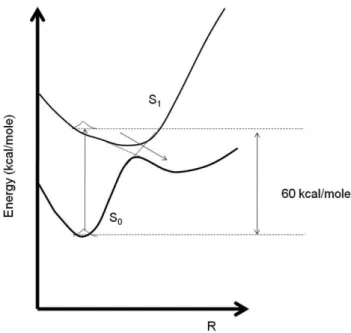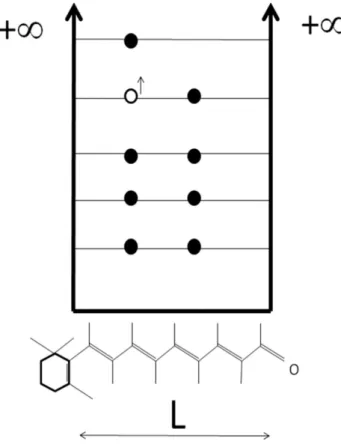Revista Brasileira de Ensino de F´ısica,v. 32, n. 2, 2303 (2010) www.sbfisica.org.br
The first steps in vision in the classroom
(Etapas iniciais para a vis˜ao na sala de aula)A.C.F. Santos
1Instituto de F´ısica, Universidade Federal do Rio de Janeiro, Rio de Janeiro, RJ, Brazil Recebido em 15/9/2009; Aceito em 31/2/2010; Publicado em 17/1/2011
We examine, using the particle-in-the-box model, the transient absorption measurements of the cis-trans isomerization by the visual pigment rhodopsin present in the retina [R.W. Schoenlein et al., Science254, 412 (1991)], which contains the retinene group, a conjugated system, which is formed by single and double carbon-carbon atoms, and works as a light antenna in the process of photon absorption. The present approach is directly applicable to the classroom in undergraduate chemistry and physics major courses.
Keywords: vision, quantum mechanics, undergraduate.
Analisamos, utilizando o modelo de po¸co de potencial infinito, o processo de absor¸c˜ao de um f´oton que leva `
a isomeriza¸c˜ao cis-trans do pigmento visual rodopsina, presente na retina [R.W. Schoenlein e cols., Science254, 412 (1991)], que consiste de um composto formado por liga¸c˜oes simples e duplas entre ´atomos de carbono, e funciona como uma antena no processo de absor¸c˜ao de um f´oton. A presente proposta ´e diretamente aplic´avel nos cursos de gradua¸c˜ao em f´ısica e qu´ımica, nas disciplinas de f´ısica moderna e f´ısico-qu´ımica, respectivamente.
Palavras-chave: vis˜ao, mecˆanica quˆantica, gradua¸c˜ao.
1. Introduction
The selective absorption of light by molecules is respon-sible for the color of most of everyday objects, color of the eyes, the wings of butterflies, birds, vegetables, etc [1]. As opposed to most atoms and molecules, which have resonances in the ultra-violet and infrared part of the electromagnetic spectrum, the chromatic pigments as well as the photoreceptors, i.e, vision cells, contain molecules which have resonances in the visible part of the spectrum. The vision process, for pedagogical pur-poses, can be divided into a sequence of steps. After entering the eye, the light is focused on the retina. The photon is absorbed by the rhodopsin, and converted into a physiological message. In the case of living or-ganisms, the optically active molecules contained in the photoreceptors consist of a dye combined with a pro-tein, discovered by George Wald in the 1930’s [2]. The molecules absorb light and transfer the absorbed en-ergy to specific sites in order to give rise to the chem-ical processes. The effect of photons on rods contain-ing molecules of rhodopsin is to convert them rapidly to molecules of retinal. From the excited state, a ra-diationless transition to a different configuration (iso-merization). This isomerization reaction is employed as the light detection mechanism in the eye. The visi-ble photons have energies from 1.6 eV (red) to 3.2 eV
(violet), which are low compared to normal electronic excitations, and at the same time very large compared to the molecular vibrational excitations. There exists a large number of organic pigment molecules, which have ressonances in the visible, like those present in blood. The chlorophylls constitute another group of natural pigments where part of of the long chain closes in a ring. They have at least two functions: they serve to absorb radiation energy as light antennae, and they are responsible for the primary process of photosynthesis in the reaction centre. In common, the organic pig-ment molecules, whether natural, whether synthetic, have long molecular chains constituted by single and double carbon-carbon bonds, which are known as con-jugated systems [2]. One example is the rhodopsin, Greek for rose-vision, formerly known as visual purple, which is a big protein that contains the retinene group and plays a fundamental role in the absorption of light. They constitute states of large wavelength and low en-ergy. The energy required to excite the weakly bond pi electrons, in which the magnitude of the component of the orbital angular momentum of each electron along the molecular axis is h, is relatively low, lying in the visible range. The molecules are viewed as a light an-tennae, or oscillators with resonance in the visible. For details about the mechanisms of seeing, the reader is referred to Refs. [3-8].
1E-mail: toni@if.ufrj.br.
2303-2 Santos
The absorption of visible radiation by pi electrons is analog to the metalic grid which absorbs in the mi-crowave (Fig. 1). The component of the electric field paralell to the wires accelerates the free electrons in the metal and they may move all the way up and down along the wires. In the case of the metallic grid, the en-ergy absorbed by the electrons is converted into heat by the Joule effect, while in the case of retinal, the energy is converted into a nerve impulse in the optic nerve by the functional units surrounding the rhodopsin molecules. Humans beings cannot produce the retinal molecule in their cells [3-8]. One obtains it from the vitamin A, and the absence of this vitamin, provoke the phenomenon night blind.
Figure 1 - The left side (A) shows the microwave absorption by a metalic grid, where the free electrons in the wires are accelerated by the paralell component of the electric field. This system is the analog of the visible photon absorption by the weakly bond non-localised pi-electrons in the retinal molecule (shown in part B), which acts as a light antennae.
In this paper, we apply a very simple model, namely the particle in a box , also known as free-electron molecular-orbital (FE-MO) method [9], in order to esti-mate the longest absorption wavelength of the retinene molecule. This description is behind the physical basis of the very complex mechanism of seeing. The present informal and rough approach is suitable for either intro-ductory quantum mechanics or advanced optics courses.
1.1. The model
It is well known that a retinal rod can detect a sin-gle photon [3-6]. Vision commences when a photon is absorbed by the visual pigment and converted into elec-trical signals which are processed within the retina and sent to the brain. Figure 2 shows schematically the So →S1 electronic vertical transition (11-cis→11-trans
isomerization) in rhodopsin [4]. The energy difference between these two states (60 kcal/mole) corresponds to a green photon, which corroborates with the absorption curve of the main pigment in retina, the visual purple (rhodopsin), which has a maximum around 5000 ˚A [6].
Figure 2 - Schematic ground-state singlet (So) and first
excited-singlet state (S1) potential energy surfaces for isomerization in rodopsin (adapted from Refs. [4] and [5]). The arrow represents the isomerization process.
Modeling medium and large molecules is a difficult task. For practical purposes, the molecular orbitals can be separated and treated distinctly in two ways, namely, the strongly bond and localisedσorbitals, and the weakly bond and delocalised π orbitals. The dif-ferent symmetry characters of both orbitals, and the higher susceptibility of the pi electrons to external per-turbations, such as a photon absorption, is the main justification for this approach. Many of the molecules of interest in organic chemistry have conjugated single and double carbon-carbon bonds. The alternate char-acter of the bonds provides a kind of loosing or delocal-ization to the electrons. Each carbon atom contributes with one non-localised electron.
In the FE-MO method, developed in the 50’s by Kuhn, Bayliss, Platt, and Simpson, the (see for in-stance Ref. [10] and references therein) pi electrons are treated within the independent particle model (IPM),
i.e., the electron-electron Coulomb correlations 1/rij
are neglected, and the effect of the nuclei and the core electrons is represented by a particle-in-a-box potential, and the sigma orbitals will be disregarded. In general, the theoretical outcomes of this simple model is sur-prisingly in good agreeing with the experimental val-ues [10].
The box, is a potential well of effective width
L = Nd, whereN is the number of carbon atoms (or pi
electrons) in the active chain and d is the average dis-tance of the C-C bond (∼1,4 ˚A for conjugated systems)
The first steps in vision in the classroom 2303-3
Figure 3 - The infinite potential well of width L proportional to the number of carbon atoms, where the lowestN/2 energy levels are filled by the N pi-electrons. The longest-wavelength elec-tronic transition from the highest filled to the lowest unoccupied orbital is illustrated.
The Pauli principle is added in anad hocway. Each
electron is put in a spin-orbital (2 electrons is a spa-cial molecular orbital). In the ground state, the N pi-electrons fill the firstN/2 lowest energy levels as shown in Fig. 3.
The rod cells are sensitive to as little as one photon each. After an absorption of a photon, the molecule undergoes a electronic transition to an unocupied or-bital. The energy level of a particle of massmin a box of width Lis given by
En=
h2n2
8mL2. (1)
The selection rule for the infinite potential well al-lows the quantum numbernto change by an odd integer [10]. The energy absorbed in the transition nto n+ 1 is given by
∆E=En+1−En =
h2(2n+ 1)
8mL2 . (2)
As mentioned above, the N pi-electrons, fill the
n = N/2 lowest energy levels. Then, using the above assumptions, we have
∆E= h
2(N+ 1)
8md2N2 = 19,2
(N+ 1)
N2 eV. (3)
Figure 4 - The energy acquired by a conjugated system after an absorption of a photon, corresponding to the longest-wavelength electronic transition (Eq. (3)), ∆E in eV, as a function of the effective number of carbon atoms in the chain. For display pur-poses, ∆E is plotted as a continnum function. The horizontal lines represent the visible part of the electromagnetic spectrum (1.6-3.2 eV). The corresponding photon wavelengths can be cal-culated usingλ(˚A) = 12398/E(eV).
For the case of the retinal molecule, illustrated in Figs. 3 and 4, if one assumes that the effective length L, of the optically active part of the molecule is 12,6 ˚A or 9 carbon atoms, the transition energy is∼2.5 eV .
This is in agreement with the So →S1 electronic
tran-sition (11-cis→11-trans isomerization) in rhodopsin [4,
5]. This energy corresponds to a green photon, which corroborates with the absorption curve of the main pig-ment in retina, the visual purple (rhodopsin), which has a maximum around 5000 ˚A [6].
From Eq. (3) and Fig. 4 we see that, in this na¨ıve model, the electronic energy levels, and then the spec-tral sensitivity depend strongly on the effective number of carbons atoms in the chain. For largeN, the tran-sition energy goes as∼1/N. The spectral sensitivity is
controlled by a combination the amino acid sequence of the opsin. By performing small structural modifications in the molecule, changing the width of the well for in-stance, the absorption spectrum can be shifted. Living organisms make use of this fact when they exist under conditions where the light has a diferent spectral com-position than that of normal sunlight. Color depends on the light intensity. For a very interesting description of color vision and the mechanisms os seeing, the reader is refered to chapters 35 and 36 of Ref. [6].
1.2. Summary
2303-4 Santos
molecule corroborates with the absorption curve of the main pigment in retina, the visual purple (rhodopsin), wich has a maximum around 5000 ˚A. The rigor in ex-position was sacrificed in the benefit of a consistent ac-count of the physical basis of the vision process.
References
[1] E. Hecht,Optica´ (Funda¸c˜ao Calouste Gulbenkian, Lis-boa 1991).
[2] G. Wald, Science162, 230 (1968).
[3] V.Y. Arshavsky, T.D. Lamb and E.M. Pugh, Annu. Rev. Physiol.,64, 153 (2002).
[4] R.W. Schoenlein, L.A. Peteanu, R.A. Mathies and C.V. Shank, Science254, 412 (1991).
[5] L.A. Peteanu, R.W. Schoenlein, Q. Wang, R.A. Math-ies and C.V. Shank, Proc. Natl. Acad. Sci. USA 90, 11762 (1993).
[6] F. Rieke and D.A. Baylor, Rev. Mod. Phys.,70, 1027 (1998).
[7] H.Haken and H.C. Wolf, Molecular Physics and Ele-ments of Quantum Chemistry (Springer, Berlin, New York, 1992).
[8] R.P. Feynman, R.B. Leighton and M. Sands,The Feyn-man Lectures on Physics(Addison-Wesley Publish. Co, Massachussets 1964), v. 1.
[9] J.H. Mauldin, Ligth, Lasers and Optics (Tab Books Inc., Blue Ridge Summit, Pa., 1988).

